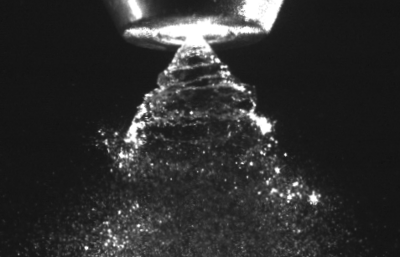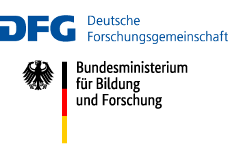Atomization of fluids
Grant number
-
Project leader
Prof. Dr.-Ing. habil. Martin Sommerfeld
Realized by
Dipl.-Ing. Elke Deux
Keyywords
Atomization, breakup, numerical calculation
Short description of the project
The project deals with liquid atomization. This technologically important process should be analytically and numerically investigated to obtain a model describing all the processes occuring during atomization. A model for calculation of the breakup of jets and liquid sheets is developed and implemented in an in-house calculation program basing on the Euler/Lagrange approach. A two fluid model or Euler/Euler method is used to calculate the flow in the nozzle and the near nozzle region up to the point where the breakup starts and delivers the values for the drop size and drop velocity distribution. A result for a two-fluid nozzle obtained with the in-house code ELSA22 is shown in the following figure (two dimensional, axisymmetrical calculation). The coloured contour represents the gas phase velocity whereas the vectors show the liquid phase velocity.
 |
| Photo 1: two-dimensional, rotaionally symmetrical calculation |
Further theoretical investigations should evaluate the drop size distribution using the maximum entropy concept. The necessary length scale should be obtained from linear stability analysis of the two fluid model. The validity has to be proved by nonlinear stability analyses and the determination of similarity solutions. The results of the stability analyses should also be used for the numerical calculations with the Euler/Euler method.
During the last part of the project the coupling between the two fluid model and the Euler/Lagrange approach will be investigated. Besides, different drop breakup and collision models will be implemented and further developed. Up to now, the validation and evaluation of the theory and the developed model is done with results obtained from the literature. However, during the next project stages experiments carried out at other institutes, e.g. at the chair of Prof. Tropea, TU Darmstadt (pressure atomizer) and at the chair of Prof. Walzel, GH Essen (hollow cone atomizer), will be considered, as well.
 |
 |
| Photo 2 and 3: Example for the atomization of fluids | |






